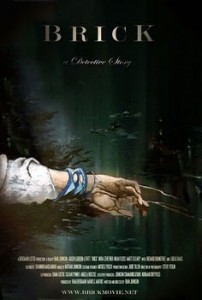From Hungry Rats:
You went from class to class, and notes about you went behind your back and the teachers pretended not to notice. When teens walk their sneakers squeak and when they squeak they slide and when they slide they turn heads on giraffe-long necks. When teens glare you down it’s so genuine that even the most twisted Machiavellian must come to terms with and do penance to such obstinate sincerity. Nobody loves like an teenager loves, and nothing is as hateful distilled as the hate in teenage eyes. Those eyes drip with angry tears, an angry ichor ink.
You wished to put a Sharpie through such eyes.
In many ways, Hungry Rats might claim to be antecedent to its own genre. The term “teen noir” has popped up in the last few years as primarily exemplified by the film Brick (2005) and the television series Veronica Mars (2004-2006). I drafted Hungry Rats in 2003.
But bragging on this count would be more than a little unfair. Twin Peaks (1990-1991), to name just one influential example, has just as bad a case of teen noir as either of the other works. Shows such as Buffy the Vampire Slayer (1997-2003) and scores of novels (including 25 years of Christopher Pike’s work) also fall into this genre. It turns out that pop culture high schoolers have been brooding in the darkness for as long as there has been high school. The ascendancy of the genre these days has more to do with the thirsts of American audiences than with the predilections of writers and artists.
Given a number of critical and commercial successes, it is clear the the synthesis can work. But why? What is teen noir, really?
Today, the Chicago Tribune published a review of the movie Brick which talks at length about the — partially budget-inspired — decision to film the piece at a high school and the influence of the novels of Dashiell Hammett. ‘High school,’ the article asserts, ‘with its ludicrously high stakes, “has a lot of strange similarities to the conventions of crime fiction. It just lined up in an odd way.”‘
That’s at least a start. Both teen dramas and noir have in common a very stylized, symbolic vocabulary.
Teenagers (at least, fictionalized teenagers) have come into a knowledge of their powers, but not of their own inexperience. As new adults they have the full potential of their whole lives ahead of them, but this leads to an arrogance and the possibility of disaster. It is both why material affluence (which enhances arrogance) and Miltonic downfall (which results from it) are conspicuous features of so many teen dramas.
Noir, by comparison, is entirely interior looking. “There is nothing escapist about the black novel whatever,” wrote Derek Raymond. “The writer cannot even escape himself in it; the black novel is the novel in which escape is shut off.” The horror and violence of the larger world is only effective when it reflects the horror and violence of the human mind.
So do we, as consumers who are, for the most part, not in high school ourselves, look to these symbolic landscapes to find a story pregnant with youthful idealism and opportunity but clouded by misery and turbulence? Is this interest a reflection of our own fear of entropy and instability? Is it, perhaps, even a response to the last decade, with its economic collapse, two wars, terrorist attacks, and cultural inertia?
It is certainly plausible.
At the very least, it is not a coincidence that certain art forms become popular at certain times. Jazz was around for decades before the Great Depression made it popular. The Gothic Novel rose and fell with the French Revolution. Teen noir is nothing new, but it is absolutely something timely.
This timeliness gives me hope for the success of Hungry Rats. Veronica Mars, Twin Peaks, Buffy the Vampire Slayer, Brick. Christopher Pike. If you’ve got friends or colleagues who’ve enjoyed these works and their cousins, invite them to take a look at Hungry Rats. They’re all part of the same big family.
